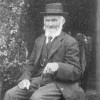The south coast of England in particular has had a long tradition of smuggling, especially where there are many coves or inlets ideal for concealing contraband. Devon and Cornwall are particularly well endowed in this regard, but Dorset has hardly been less important as a focus for the trade. The life of Isaac Gulliver, the ‘smuggler’s king’ of Dorset, has been covered in a biographic feature on the site, here I am considering the more general look at smuggling and what motivated people to become involved in its illegal operations.
Usually thought of as a male preserve, what may at first surprise many people is the extent to which women were also involved. Some of these would have been smugglers wives, though this is not invariably the case. Dorset, in the heyday of smuggling, was of course a very rural and sparsely populated county, with much agrarian poverty. The business of importing goods, usually liquor, from cross-channel boats under the cover of darkness in order to flout excise regulations was a lucrative sideline that impoverished families living within a few miles of the coast would find too great a temptation to overlook.
The register for Dorchester Gaol 1782-1853 lists the names and occupations of no fewer than 64 women convicted of various smuggling related offences. Twenty one of these (32%) were from Portland alone, while just six resided in Weymouth, five in Bridport, three in Bere Regis and two in Lyme Regis. The parishes of another nine are not recorded. Wool and Woolbridge, Preston, Pulham, Sutton Poyntz, Langton Matravers, Marnhull, Morecombelake, Beaminster, Bradpole, Broadwindsor, Buckland Ripers, Charmouth, Chetnole, Chickerell, Corfe, Dorchester and Kington Magna account for the remaining sixteen.
Three notable examples are Charlotte Drake of Bridport and Ann Maidment, a Bridport buttoner, who both assaulted and obstructed excise officers, and Mary Applin of Langton, who committed an excise offence. Martha Lumb of Weymouth was sentenced to three months hard labour in 1822 for smuggling, while Catherine Winter, a Weymouth seamstress, served an 18-day sentence in 1844 for smuggling at the age of 70!
But regardless of the sex of the offender, for the populace as a whole, smuggling was generally considered an honourable trade. The customs officers or the “King’s Men” were responsible for ensuring that contraband was impounded and fines levied. At Poole the problem of smuggling was so rampant and the customs men so understaffed and overworked that Dragoons had to be deployed to assist them as early as 1723. Typically the customs officers were brave and resourceful with a strict code of conduct; so that names were never banded about and nothing ever put in writing.
Poole was especially ideal for smuggling operations because of the exceptional size and highly indented nature of its harbour, the second largest natural harbour in the world. Goods were disembarked into inlet hideaways at Hamworthy and then transported by waggoners to Bristol via Blandford. Furthermore, goods could be offloaded on the south Purbeck coast and hauled overland to be temporarily laid up in the deep inlets such as those at Arne or the Goathorn Peninsula for later distribution to Poole markets without the smugglers having to risk detection by passing through the harbour mouth. Longfleet and Parkstone farmers constructed secret tunnels down to the water’s edge for bringing goods ashore.
After 1759 the volume of smuggled goods passing through Poole significantly increased, though raised vigilance on the part of the Preventatives gradually brought this down. The Commissioners of Customs based in London frequently requested reports on the amount of smuggling going on in the Poole area.
Although landings and disembarkation operations took place from Lyme Regis to Christchurch, the coast from Portland westwards to Lyme attracted special attention. This was because most of the coast is occupied by the Chesil Bank, a shingle spit enclosing a lagoon (the Fleet) which was a convenient storage-sink to hold casks (“tubs”) for collection at a more appropriate time. One memorable incident took place in 1762 when a Cornish vessel was broken up on the Chesil in a winter storm and its cargo washed into the sea. There then followed a desperate attempt by Weymouth citizens to salvage what tubs of liquor they could before the customs house officers could reach them! In the end the citizens claimed 26 tubs to the revenue’s 10; another ten were cast out to sea but recovered the next day.
Probably the greatest hideout and smugglers haunt along this coast was Lulworth Castle, the seat of the Weld family, but which had a connection with smuggling throughout the 18th century from 1719 onwards. In 1719 revenue officers from Weymouth raided the castle and the entire Lulworth area. It has been said that maids working at the castle would routinely warn smugglers when the customs men were in the vicinity by showing a light at a window to indicate when it was safe to come in, but also act as a bearing. The gangs at Lulworth could comprise as many as 100 disguised and heavily armed men, who used Mupe Rocks as the disembarkation point, but the deep ravines and inlets along the coast west of Kimmeridge were also ideal for concealing kegs. A gap in the cliffs at Worbarrow Bay was a special favourite and tubs were raised to the top of Gad Cliff, and brought ashore at Arish Mell and for storage at Tyneham Church.
On a knoll near the coast between West Bexington and Puncknowle there still stands an unusual monument. This is The Lookout, a square building constructed as a signal-station for the Fensibles, but which may also have been used by Isaac Gulliver, who used the Bexingtons, Swyre and Burton Bradstock as landing sites after 1776.
Lyme Regis has had an especially long smuggling history extending back at least as far as the 16th century, when certain merchants were suspected of smuggling bullion out of the country by sea. In 1576 a revenue man called Ralph Lane was sent to Lyme with a deputy bearing a warrant to search ships alleged to be involved in the operations. His arrival however, provoked a riot during which the warrant was seized and Lane’s deputy was thrown into the sea. From Lyme contraband was traditionally floated up the Buddle River, often under the noses of the Preventives, who were frequently understaffed and restrained by bureaucratic regulations. Booty offloaded onto the Cobb could not be inspected until it had been carried half a mile to the Cobb Gate. Lyme is believed to be the birthplace of Warren Lisle, a customs officer who at 17 was appointed Patent Searcher at Poole and who made his first seizure of a cargo from a small vessel in Portland Harbour in 1724.
Weymouth was central to excise operations for the sea, but the town’s revenue officials had a long and shameful history of ineptitude and corruption. Enter George Whelplay, who in the 16th century failed to make any headway in countering popular local support for smuggling. Originally a London haberdasher, Whelplay came to Dorset to try his fortune as a public informer, and as such could claim a fifty per cent commission on each fine he imposed upon those he caught, but in 1538 he incurred the wrath of smugglers and fellow customs officers alike when he exceeded his remit. Whelplay twice stumbled on a cargo of horses being illegally shipped to France, but instead of coming to his assistance in rounding up the French boats the officials joined a gang of merchants and attacked him.
Around 1830 smuggling reached a climax in the Weymouth area, where, it is said; tunnels were constructed from the harbour to merchant’s houses and even to the residence of King George III. The leading figure in smuggling to be connected with Weymouth was Pierre Latour, otherwise known as French Peter, who functioned as a prominent gang-leader in the town. In Wyke Regis churchyard there is a grave of one William Lewis, a smuggler shot dead by a revenue officer on board the schooner Pigmy.
In conclusion, anyone who has anything to do with Dorset will know of Thomas Hardy, the well-known novelist-poet. Less well known is that Hardy was an authority on smuggling – and not without good reason. His birthplace cottage at Highter Bockhampton was actually a capacious safehouse for smuggled contraband that could accommodate up to 80 casks of brandy. “But this isn’tall.” When a child, Hardy was regaled with smuggling stories from his grandfather and his own father had a manservant who was actually involved in the trade. The Bockhampton cottage lay on the smugglers route between Osmington Mills and their markets in Sherborne and Yeovil.



